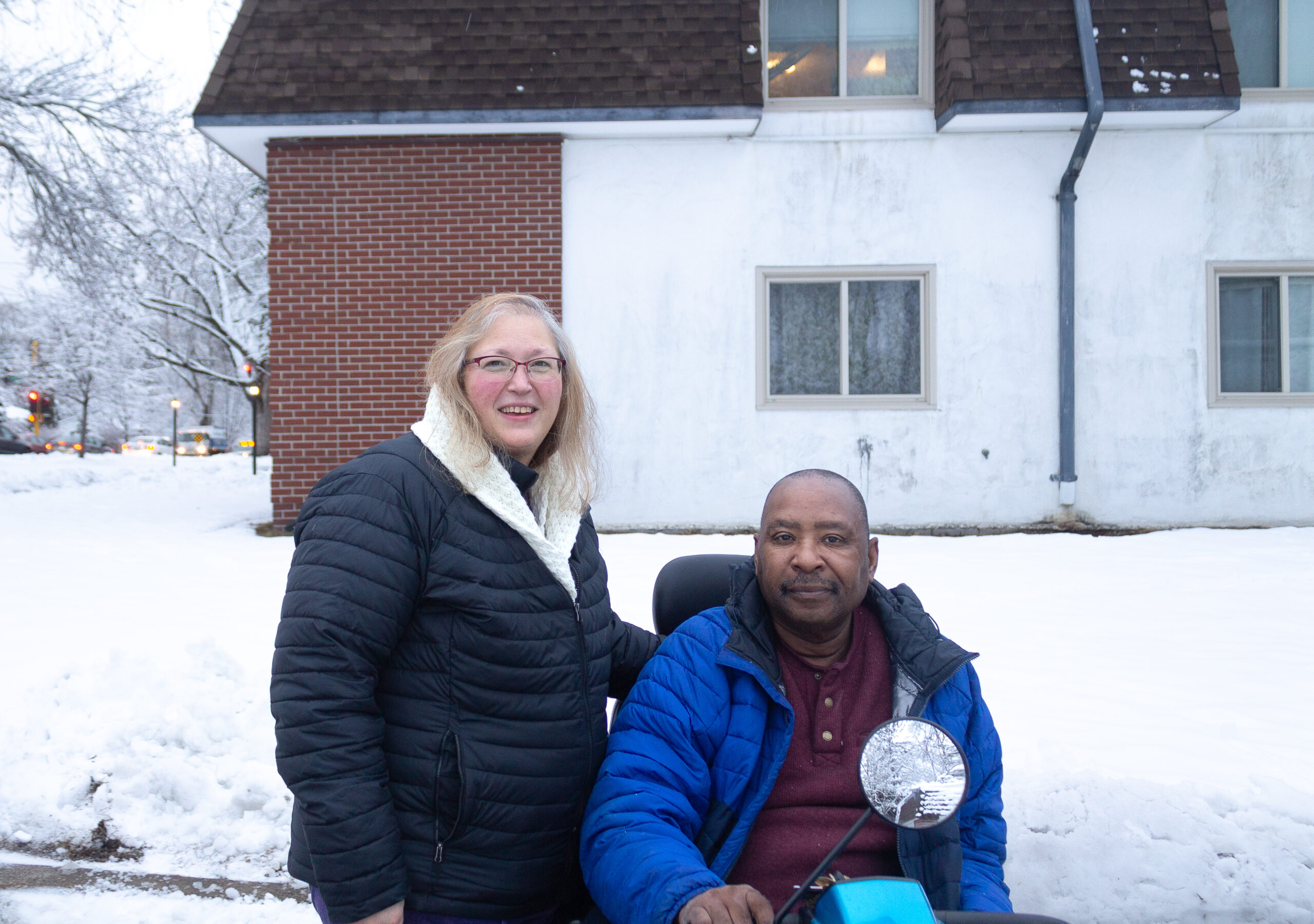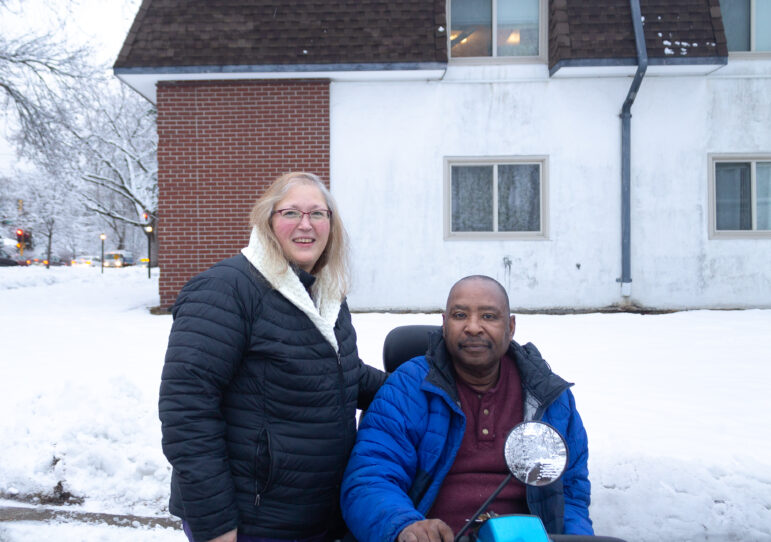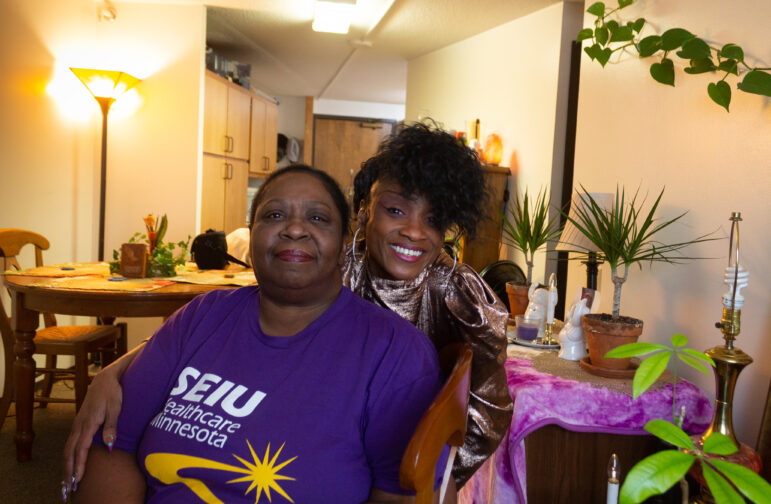
Gail Larson and her partner, Ronald, pose in front on their home in Bloomington, Minnesota.

Share
Home care workers are negotiating their contract in hopes that the state will allocate some of the $17.6 billion surplus to improve pay and benefits—a test of the state’s Democratic trifecta’s political will to solve a worsening crisis for disabled people and their caregivers.
Gail Larson lives in Bloomington, Minnesota with her fiancé, with whom she has been partners for 20 years. For years, they did not marry due to a federal law that prohibits most married people from working as Medicaid-funded personal care assistants (PCAs) for their spouses.* Her fiancé, Ronald, is a veteran who suffered a traumatic brain injury and has other physical and mental health needs.
She describes how caring for a family member is unique because family members never truly clock out, no matter how many hours the state approves them for. “As a PCA , if the client is the person that you live with, it’s all day, no matter how many hours we are given.” The blurred line between spouse and PCA means she works many hours that she is not compensated for, Larson says.
She worries for the future, especially considering the lack of retirement benefits and her own health ability to provide care for her and her husband as the physical toll on her body builds over time. She wonders, “Who’s gonna care for us when we need the care?”

She is not the only worker grappling with this question. Larson is one of more than 20,000 Minnesota home care workers, whose salaries are funded by Medicaid, negotiating a new contract with the state of Minnesota amid a crisis-level labor shortage that workers say is driven by poor pay and conditions. The workers, represented by SEIU Healthcare Minnesota and Iowa, are fighting for a wage floor of at least $20 an hour (the current base wage is $15.25), overtime pay, and retirement benefits.
They labor in an industry where wages are low, and women of color are disproportionately represented. A report by the Center for Women, Gender and Public Policy at the University of Minnesota finds that women make up 85% of the entire direct care workforce in Minnesota, and of those workers, 36% are people of color. “On a national level”, the report notes, “Black women are overrepresented in direct care occupations, reflecting a legacy of slavery and domestic servanthood that persists in our labor market today.” Direct home care workers are also some of the lowest paid in the medical field, with over 40% of those in Minnesota earning wages that are below 200% of the federal poverty line.
Not only is the industry made up of marginalized and exploited workers, the population these workers serve—disabled people—have also been historically overlooked, underserved, and at times treated as disposable. In Minnesota, tens of thousands of disabled people were institutionalized at state hospitals through the 1990s. Patients who died while in the state’s care without money or family relationships were routinely buried in unmarked gravesites, at times with only a number to identify them.
Today, people who are not able to receive the home care they need are often forced into group or nursing home settings—which, too, are failing to retain workers.
Union members say that one important part of stemming the crisis is making sure that the labor of home care work is properly funded as the healthcare work that it is, an important part of ensuring workers want to stay in a demanding and high-stakes field.
Because Medicaid covers the salaries of the workers who are in bargaining, union negotiations take place before the state’s budget is finalized. Once an agreement is reached and ratified by union membership, Governor Tim Walz will then include this on his state budget proposal, which will then need to be approved by the Minnesota state legislature in early 2023. Many workers insist that now is the time for improved conditions for both workers and clients, considering the Democratic trifecta in the Minnesota Senate, House, and the governor’s office, coupled with the massive state budget surplus of $17.6 billion dollars.
Larson warns that, if underinvestment continues, “It’s only gonna get worse, and the problem only gets compounded.”
A worsening crisis
Tavona Johnson, a member of the bargaining unit, has worked as a PCA for well over a decade. She lives in Austin, Minnesota, with her husband, who has stage four colon cancer, and she supports him in an unpaid capacity with his needs as well.
“I have come from a long, long history of a family who has done this work throughout their lives,” she tells Workday Magazine over the phone. “Mostly all the women in my family have worked as a PCA at one point in their life”—whether it was their lifelong career, gaining experience for other healthcare professions, or “just because they were expected to.”
Johnson says she loves her job and her clients: “I really find value in being of service to another person. That is something that truly is a part of the core of who I am. When I am able to get my clients to reach goals and do things that they never thought they would, that is the optimal payment for this work.”

During the pandemic, Johnson continued working, while many made the choice to leave the field for their own safety, which she described as straining an already tight workforce. She describes an overstretched workforce. “There’s not enough of us to provide services. During the pandemic, I found myself running from patient to patient, providing partial services, spreading myself among people so that they can get some type of service.”
“It’s taxing on your mind, body, and soul,” she says. “I’m lifting, I’m bending. It’s not just that I’m sweeping a kitchen or washing some dishes. I might have to transfer someone from their chair to their bed. My body is breaking down.”
“And I just don’t have anything to show for it,” Johnson adds. “I have no savings and live paycheck to paycheck just to support my household.”
According to Johnson, inadequate state funding for salaries and benefits is making it difficult to retain workers, which is wreaking havoc on the lives of clients. “People are being forced to be removed from their homes because they can’t receive the essential services that they need,” she says. “It’s just heartbreaking.”
But the problems don’t stop at home care, Johnson says. “We’re going to have a whole other crisis where the group homes, rehabilitation centers, and nursing homes are going to be overcrowded,” she warns. “And then those workers are going to be stressed and start jumping ship.”
Home care workers warn that if clients cannot access the care they need in their own homes, many will make the sometimes difficult decision to move into group homes and nursing homes. Yet, these facilities are also struggling with staffing shortages of their own, and as the home care crisis worsens, and more people are pushed into these facilities, shortages will only intensify, workers warn.
While the low pay, lack of sufficient benefits, and low staffing levels harm the workers, it also impacts the quality of care their clients receive. Many disabled people who rely on this care say they are unable to find adequate coverage, and it is often difficult to keep PCAs longer-term.
The “snowball” effect of staffing shortages
Mao Yang, a 27-year old with cerebral palsy made the decision two years ago to move into a group home in Eden Prairie, Minnesota. As the youngest of eight siblings from a tight-knit Hmong refugee family, she wanted to explore life and her identity more independently, as many 20-somethings do. Her siblings were working as her caregivers, funded by Medicaid, for years. However, as they got older, they had their own obligations with school and careers, and it became difficult to find the coverage.

In an interview with Workday Magazine, Yang explains that her group home is facing staffing shortages that impact the quality of care she receives. As an active community member, it was important for her to find a group home that provided her with transportation into the community. Metro Mobility, a public bus service for those with disabilities and other health concerns, is not an option for her, or many others with more complex care needs. She is often unable to attend events and go into the community, as the group homes are short-staffed and unable to accommodate.
Yang emphasizes that she made the choice to live there and is grateful to live in a group home. At the same time, she’s struggled with the high rates of turnover at her facility, which impacts the quality of care, while also feeling left out of decision-making. She describes the experience of clients as “monkeys in the middle being passed around and discussed and we’re not included in that discussion.”
Improving working conditions improves quality of care
Yang is outspoken, enthusiastic, and bold when it comes to demanding the quality of care she knows she deserves, and she wants other disabled people to feel empowered to do the same. She encourages other disabled people living through situations where they are receiving inadequate care, “Don’t be afraid to ask for what you want or need. Be firm when it comes to asking for what you want and just because no one has asked or questioned what you have wondered about, that does not mean that you can’t be the first. So don’t be afraid to be that one person.”
Yang’s attitude reflects the urgency of clients and home care workers alike. The fight to improve staffing, pay, and benefits can incentivize workers to join the field and improve retention, which can also improve the quality of care clients receive. The fight for better working conditions for workers, and the fight for improving quality of care for clients, are inherently linked.
Andrew, who asked for his name to be changed for this article, is a 36-year-old with autism who has lived in a group home in St. Paul, Minnesota for over fifteen years. He enjoys fishing, hiking, and creative writing. Like Yang, Andrew wants to be in the community and shares a similar frustration toward his group home’s short staffing that makes it more difficult to leave the home and be in the community.
While he has had his share of nightmarish experiences with PCAs in the past, he lights up when talking about the good experiences—caregivers who would go on walks in the woods with him, who have shown him interesting music, or who went the extra mile to make him delicious breakfast sandwiches. Andrew wants to see a change in the industry so that the good staff can actually stay, improving both the workers’ conditions and his quality of life.
Andrew knows that staff are trying their best, but he still wants people to know that these PCAs are a lifeline for people like him and that this industry cannot continue to be underfunded and treated just like any old job. With such high rates of turnover, Andrew says, “Where does this leave me?” He adds, “I’m someone who really needs this help.” He pleads that these jobs demand a serious commitment and compassion for the people they work for and that improving worker conditions is a step in the right direction.
The impact on families
Home care work is a unique industry because it takes place in the home and is often provided by—or in close collaboration with—the clients’ families. Johnson explains that “because you are performing the most intimate of intimate duties, you form a relationship that’s built on trust, dependability, and reliability.”
While the intimate relationship that comes from this type of work can form lifelong bonds between clients and workers, it can also be a source of stress and hardship for family members who step into this role. A spokesperson from SEIU Healthcare explained that with staffing shortages, the union is seeing many family members who are forced to leave better paying jobs with benefits in order to take care of their loved ones.
The spokesperson explained that some clients are given a budget to work with, meaning they can choose fewer hours but higher wages for their caregivers, in programs that potentially incentivize clients to receive less than the care they need, in order to pay a fair wage. About half of the bargaining unit is employed under such programs, the spokesperson said. For clients who receive less flexible home care, where they don’t get to make decisions on budget, a greater share are people of color, state data shows.
At a Minnesota Legislature Senate Human Services hearing on the long-term care staffing crisis in November 2022, Delores Flynn from Roseville, Minnesota, spoke on behalf of her union. Flynn and her husband, both 78 years old, are full-time, round-the-clock caregivers for their 51-year-old son Scott, who suffered a massive brain hemorrhage.
Scott requires complex care. He is 6’2, 176 pounds, nonverbal, wears a diaper, and needs to be transferred by two people at a time. Delores asserted at the hearing that Scott “has a right to compassionate care with dignity and respect in his own home.”
While staffing was less than ideal even before, the pandemic has brought a full-blown crisis for the family. With an intense workload, low wages, and minimal benefits, Delores and her husband are now full-time caregivers, struggling to find and retain workers to care for Scott.
The crisis in direct home care workers poses danger and physical injury for both caregivers and clients, especially elderly parents who often are forced into this role, despite injuries and disabilities of their own. Both Delores and her husband have heart and back problems. Delores needs a knee replacement and cannot schedule one due to the lack of coverage for Scott.
Delores’ husband has fallen while transferring Scott, resulting in injuries for both him and his son, she explained at the hearing. Delores has dislocated her knee, and Scott has suffered from head injuries, bruises, sprains, and a fractured elbow. The family has had to call neighbors and the Roseville Fire Department.
The state of Minnesota and the home care workers will be negotiating through the end of 2022. Many caregivers and their clients agree that it often feels like these crucial decisions and those in power are far removed from the everyday realities of home care workers and the disabled people who rely on their care. After decades of underfunding and a daily crisis for care for so many families, the coming weeks will tell if Minnesota state leadership will hear their calls for change.
As Delores puts it, “If I could offer well over $20 an hour with benefits, such as retirement or even overtime, a wage that people can live on, then I could attract and retain the help my family needs and other families need.”
*Minnesota was granted a temporarily waiver from this federal law during the pandemic.

